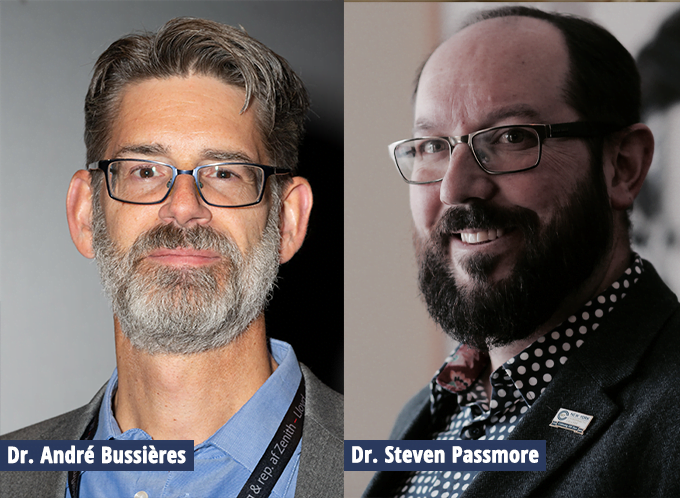Improving the health of patients in remote communities


Suffering from back pain or neck pain is not fun, but when you live in an urban center, there are numerous treatment options to choose from. But what about people with musculoskeletal problems living in remote communities, where accessing healthcare is challenging? “Our goal is to address this limited access issue by implementing a model of care for spine disorders and associated disabilities in underserved communities in northern Canada and around the world,” says Dr. André Bussières, professor in the department of chiropractic at Université du Québec à Trois-Rivières (UQTR).
The loss of productivity caused by back and neck pain combined with the assessment and treatment of these problems is a major expense for governments around the world. In Canada, this represents spending of over $16 billion and in the United States, $100 billion-USD each year.
The initiative led by the UQTR researcher and his colleague Dr. Steven Passmore from the University of Manitoba, will validate a model of spinal care in the Indigenous community of Pimicikamak (Cross Lake First Nation), Manitoba, Canada. Their proposal is part of the Global Spine Care Initiative (GSCI), which aims to work with underserved communities around the world.
The implementation of the GSCI model of care in the community of Pimicikamak is part of a larger project, comprising four phases and involving an international team of researchers and partners from France, England, the United States, Botswana, and India.
A model of care adapted to remote communities
The first phase of the project (now completed) led to the creation of a model of spinal care and healthcare services to better serve patients in remote communities. The sixteen published scientific articles laid the theoretical foundations for the model that will be explored in the Pimicikamak community.
“The model of care has two main components. First, triaging people with back or neck pain, using the GSCI classification of problems that may be encountered,” explains Professor Bussières. “Second, to provide the primary care recommended by the clinical practice guides, including self-management strategies and advice regarding, for instance, ergonomics at work and the prescription of exercises. If the patient requires primary care treatment, it would be possible for chiropractors, physiotherapists, massage therapists or kinesiologists to offer care.”
For her part, Dr. Jennifer Ward, DC, said: “It is with great pride that I, as an Indigenous Canadian chiropractor, have had the opportunity to deliver spinal care to Cree communities in northern MB the past 18 years. With this new opportunity, I look forward to being part of an amazing research team to both learn from the community and to deliver the WSC’s Model of Care to the people of Pimicikamak. It is through these types of collaborative research efforts done in a for us/with us approach that will assist policy makers in rectifying our healthcare system.”
Implementation and validation of the care model
With his expertise in implementation science, Professor Bussières will lead phases 2 and 3 of the project, in collaboration with Professor Steven Passmore and their colleagues. The first step is to consult with the partners, the people with back and neck pain in the Indigenous community of Pimicikamak to prepare the implementation of the model (phase 2), and then conduct a feasibility study (phase 3). The results obtained in phases 2 and 3 will lead to the evaluation of the impact of the model, adapted to the local context, on the health of patients (phase 4).
“What we are proposing in Pimicikamak is for the chiropractor to make the first contact, perform triage and provide primary care tailored to patient needs on a weekly basis in the community. If a patient requires a specialized consultation, it can be done virtually with medical specialists, and if necessary, the patient he can be transferred to a Winnipeg hospital to receive needed health care,” explains André Bussières, whose team has received a grant of $195,000 over two years, including $45,000 from the Canadian Chiropractic Research Foundation (FRCC/CCRF) and $150,000 from the Canadian Chiropractic Association (ACC/CCA).
“The CCA is pleased to be supporting such an important project, which marries patient-centered care to the very real need to consider patient context and traditions during treatment,” says Alison Dantas, Chief Executive Officer at CCA. “It is an excellent opportunity to provide care to underserved areas, and to bring chiropractic treatment into an Indigenous framework.”
Robert Harris, CCRF’s Executive Director add: “CCRF is pleased to be a funding partner in support of this exceptionally collaborative study. Establishing appropriate models of care for remote communities is an excellent initiative that’s well aligned with our foundation’s mission to invest in high-impact national research.”
Challenges and learning opportunities
There will be a few challenges facing the researchers: geographic access to the remote community; learning a new language; different visions of healing; and possibly, the financial sustainability of the model of care. However, there are many opportunities to learn, for example, speak a new language, celebrate cultural differences and learn about their vision of traditional healing and holistic care. “We must be sensitive to these challenges and embrace differences in order to establish a strong and lasting partnership, so that the stakeholders and the inhabitants of the community are involved in the development while respecting, among other things, their vision and their way of doing things,” says the UQTR researcher.
“We must first understand the interest and capacity of the environment to welcome change, and work with individuals, as well as listening to community voices including patients, local leaders, nursing station staff and also Indigenous healers who practice care more based on ancestral tradition. What is interesting and positive is that manual therapy represents for them this holistic vision of care that respects the choices of the individual,” concludes André Bussières.

